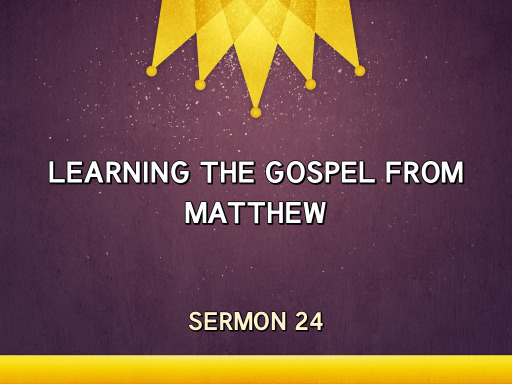How Does Jesus Fulfill the Law & Prophets (LGFM #23)

Notes
Transcript
Sermon Tone Analysis
A
D
F
J
S
Emotion
A
C
T
Language
O
C
E
A
E
Social
Series Review:
Series Review:
Review of Matthew:
Review of Matthew:
Matthew was a tax collector by trade
(T/F) - Matthew was one of the 12 Apostles? True
Intended Audience
Intended Audience
Two groups
Jewish-Christian audience
Unbelieving Jewish audience
Matthew’s presentation of Jesus
Matthew’s presentation of Jesus
Matthew helps link Jesus of Nazareth to the fulfillment of Old Testament prophesies regarding the Messiah.
Jesus is presented as Israel’s Messiah-King
Sermon on the Mount
Sermon on the Mount
Purpose
the king is presenting the requirements of the kingdom
The requirements are NOT the means of access but rather the character of its true citizens
Conduct flows out of character
The sermon on the mount reveals mans hopelessness apart from the new-birth
I what way does Jesus fulfill the law and prophets?
I what way does Jesus fulfill the law and prophets?
17 Think not that I am come to destroy the law, or the prophets: I am not come to destroy, but to fulfil.
How do we figure it out?
How do we figure it out?
Common theories:
Jesus establishes, confirms, ratifies the law
The law is incomplete, and Jesus fills it up, completes the giving of the law
Jesus fulfills the law by perfect obedience to the demands of the law
Jesus fulfills the law by restoring God’s original intention for the law
Why does it matter?
Why does it matter?
Theonomy!
View #1 - Jesus established law of Moses, and confirmed it as God’s established rule over all people.
an understanding of Theonomy (also called Reconstructionism)
Dictionary of Christianity in America Reconstructionism, Christian
Reconstructionism, Christian. A fundamentalist-evangelical movement, dating from the early 1960s, intent on reconstructing society along lines explicitly set forth in Old Testament law. Leaders include the acknowledged patriarch of the movement, Rousas John Rushdoony; theologian Greg Bahnsen; and economist Gary North.
Dictionary of Christianity in America Reconstructionism, Christian
Second, sometimes referred to as “theonomists,” Reconstructionists argue that Old Testament law applies today, in “exhaustive” and “minutial” detail. They anticipate a day when Christians will oversee all aspects of society, using the Bible as their guide.
. . . Governmentally, Reconstructionists expect to see the death penalty restored across the range of offenses for which it was applied in Old Testament times. This would include, for example, sodomy, Sabbath breaking and incorrigibility in children. Economically, at least some Reconstructionists expect a return to the gold standard, the abolition of property taxes and the restriction of usury (as in Deut 15). Considerable thought has also been devoted to reforming the mass media, the arts and education.
Daniel G. Reid et al., Dictionary of Christianity in America (Downers Grove, IL: InterVarsity Press, 1990).
Answering the question: Why does it matter how I understand “fulfill” in Matthew 5:17?
World View!
How do I determine what view to take?
How do I determine what view to take?
Wrong method: “I just think it means . . .”
Wrong method: “I always heard it meant . . .”
Right method discover the meaning through hermeneutical principles.
hermeneutics is the study of written, verbal, and non-verbal communication. It seeks to answer the question “what was the author trying to say?”
How does this work?
How does this work?
Word Study
Fulfill in Mt 5:17 is the Greek word πληρόω (pleróō)
Meanings and uses of pleróō
to make full, full (full) - to fill something with content (Matthew 13:47-48)
to complete a period of time (Matthew 1:7)
to bring to a completion that which was already begun - complete, finish
to bring to a designed end, fulfill a prophecy, an obligation, a promise, a law, a request, a purpose (Mt 1:22)
to bring to completion an activity in which one has been involved from its beginning, finish (Luke 1:7)
to complete - a number, i.e. have a number made complete (Rev 6:11)
Historical Analysis
how is the word generally used by the author
what is the purpose of the author for his overall writing or communication?
how has the author used this word in the same book, or some other writing?
Context
what was being said in the immediate context?
how does the context of the sentence fit with the range of definitions?
how does the context fit with the context of the rest of the Bible?
Solution:
the best answer will be the one that best fits with all three (word study, historical analysis, and context)